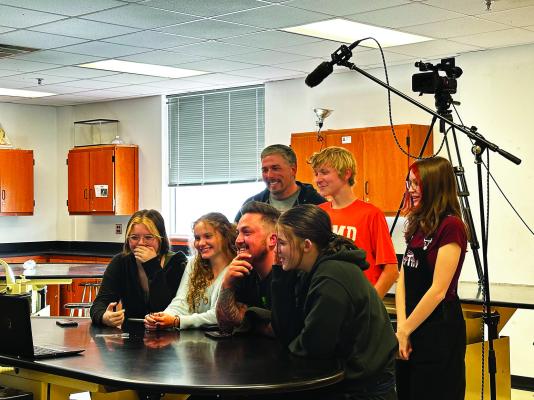‘AN OPPORTUNITY OF A LIFETIME’
Courtesy Photo/Kemp ISD
Five Kemp High School students and two of their teachers interview online with The Washington Post March 6. The interview consisted of their efforts to telescopically document the April 8 total solar eclipse in coordination with 34 other select teams across the country. Pictured are Zoe Brooks (front, from left), Katy Kiser, teacher Billy House and Lillie Moore, along with teacher Kyle Rimler, Thomas Skirko and Parker Jones.
KEMP—They may be considered “citizen scientists” by their sponsoring organization, but five Kemp High School pupils are likely the only group solely of students in Texas (if not America) selected by a prestigious research organization to help study the upcoming total solar eclipse April 8, says their teachers who are guiding their galactic odyssey.
Under the tutelage of Kemp High School (KHS) science teachers Kyle Rimler and Billy House, senior Zoe Brooks, juniors Katy Kiser and Parker Jones as well as freshmen Thomas Skirko and Lillie Moore have been preparing for weeks for the big day in April. House says the experience is an “opportunity of a lifetime. Nothing like this has ever happened –ever– for Kemp.”
The Kemp kids will collaborate with 34 other teams stretching from Maine to Texas to make polarized observations during the eclipse, focusing on the sun’s corona, according to the Southwest Research Institute’s Citizen Continental-America Telescope Eclipse (CATE) 2024 project.
Kemp’s telescope is located on land in Rosser (farther north in Kaufman County) made available to the students by owners who are known by a Kemp ISD staffer, Rimler says. Relay teams trained with identical telescopes along the eclipse path will allow a 60-minute ecliptic observation, Citizen CATE’s website states.
According to House, the students’ names will be included in a study that will be featured in an academic periodical alongside some of America’s top scientists. The students also have been interviewed for inclusion in a Washington Post newspaper story.
Kiser explains there’s three different parts to operating the telescope shared among students: putting it together, programming its alignment and handling computer controls. Brooks oversees assembling the telescope, Kiser leads its programming and Jones’ job is the computers. Moore helps Kiser and Skirko assists Brooks.
“We all kind of evenly split it out,” Kiser says. The Rosser telescope site is relatively close to the school (“We got lucky,” Kiser says, compared to others who must drive an hour or more) and was pinpointed in that pasture by scientists, she remarks. “I’ve dealt with telescopes before, but nothing with this level of technology,” Kiser states.
Continues Kiser, “It’s a great experience overall.” Adds Rimler, “Without her (Kiser), we’re lost.”
Skirko is one of Rimler’s best students, Rimler says. “I have a decent understanding of how to put things together,” Thomas deadpans.
Skirko says the experience has taught him how the sun and Earth work in tandem, and shared that the team once got stuck in the mud in the Rosser pasture while at the telescope. He says they used wood lying nearby to try to get unstuck, “but it didn’t work out.”
Other obstacles included cloud cover that affected the telescope’s computers. Adds Rimler, “The kids learned science doesn’t always happen when you want it to happen.”
Moore says she’s learned that putting up the telescope is “really difficult. Very difficult.” One problem the students have had about the telescope, Moore shares, “is which way to put it.”
House says Brooks at first could put 30 different pieces of the telescope together in 30 minutes, but now can do it in less than 10 minutes. “She’s very vital,” Rimler says of Brooks. “They’re all vital.”
In Kemp, the total eclipse’s darkness will last 4 minutes, 23 seconds, Rimler says, one of the longest such periods during the event, he states. April 8, the school district is “getting every single group in this school involved some way, somehow,” Rimler continues.
That includes Kemp High School hosting a campus-wide celebration, the "Solar Bowl," which will feature a student-led flag football game and a halftime show with band, drill team and cheer performances, Kemp ISD states. Additionally, multiple Career and Technical Education (CTE) students and their sponsors will be participating in various activities throughout the event, the school says.
“This celebration will offer a unique opportunity for KHS and Kemp Junior High students to witness the total solar eclipse in a festive atmosphere,” according to KISD. Documentary footage of the event (filmed before, during and after the eclipse) will be submitted to Daniel Zietlow (a co-investigator of the CATE project who is in charge of the documentary), KISD continues, and finally the footage will be submitted to television’s Public Broadcasting Service (PBS) and joined with video from across the United States, as other sites document their journey.
Rimler says the Kemp events will have a Texas football theme, adding local flavor to the eventual national broadcast. After the eclipse, all equipment will be donated to Kemp ISD for community use, the school district says. In addition, the school shares that House plans to establish an Astronomy Club.
"We are thrilled to bring together our students and staff members for this once-in-a-lifetime event," says Kemp ISD Superintendent Dr. James Young. "Not only will our students contribute valuable data to scientific research, but they will also have the opportunity to share in the wonder of the total solar eclipse with their school community. We are immensely grateful for the lifelong memories our students will have from this unforgettable experience."




